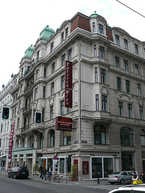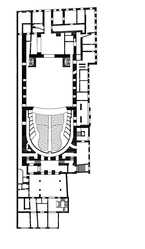Theater an der Wien
Franz Jäger the Elder
alias Theater an der Wien – Das neue Opernhaus, Kaiserl. Königl. privilegiertes Schauspielhaus Theater an der WienLinke Wienzeile 6 | |
| Auf der Karte zeigen | http://www.theater-wien.at |
Wichtige Ereignisse
The theatre opened on 13 June 1801 with a prologue written by Schikaneder followed by a performance of the opera "Alexander" by Franz Teyber. After only two years the patron and his impresario have fallen out and gone bankrupt. Schikaneder is forced to sell the theatre to his bitterest enemy, Peter Freiherr von Braun. However, being in possession of the imperial privilege (as shown by the eagle over the Papageno gate that is still visible today) he retains the post of artistic director and appoints Ludwig van Beethoven director of music and resident composer. On 3rd April 1803 Beethoven’s oratorio Christ on the Mount of Olives, his 2nd Symphony and his piano concerto in C minor are premiered in an “academy”.
Between 1900 and 1901, the architects Fellner & Helmer built a new 5-storey apartment house in front of the theatre; in the theatre itself, the 4th circle was demolished and the wooden construction of the understage replaced in steel and brick.
In 1962 the theatre found a new and successful role as a festival venue for the “Wiener Festwochen” after having undergone a reconstruction by Otto Niedermoser. The auditorium was restored to the 1838 colour design, frescoes and other stucco work brushed up, a heating- and air-conditioning system as well as a revolving stage and a new headlamp system introduced.
Menschen
Geschichte
1801 eröffnete der Theaterimpresario Emanuel Schikaneder, bekannt als Mozarts Librettist der „Zauberflöte“ (1791), sein neues Theater. Schikaneders Truppe hatte bereits jahrelang erfolgreich das kleinere, 800 Plätze fassende „Theater auf der Wieden“ in der Nähe des neuen Theaters bespielt und dort „Die Zauberflöte“ zur Uraufführung gebracht. Nun wollte Schikaneder, der großen Wert auf Ausstattung und Schaueffekte legte, ein größeres Haus mit einer besser ausgestatteten Bühne beziehen.
Bereits 1786 war ihm das kaiserliche Privileg zum Bau eines neuen Theaters erteilt worden, doch erst 1798 begann er mit der Umsetzung des Plans. Der Architekt Franz Jäger der Ältere entwarf das Theater im Empire-Stil. Es war eins der größten und am besten ausgestatteten Theater seiner Zeit.
Am 13. Juni 1801 fand die Einweihung statt: zunächst gab es einen von Schikaneder verfassten Prolog, danach die Oper „Alexander“ von Schikaneder und Tyber. Doch schon nach zwei Jahren waren der Impresario und sein Geldgeber zerstritten und bankrott. Schikaneder musste das Haus an seinen schlimmsten Feind, Peter Freiherr von Braun, verkaufen. Er behielt aber – im Besitz des kaiserlichen Privilegs (wie heute noch der Adler über dem Papageno-Tor zeigt) – die künstlerische Leitung und engagierte Ludwig van Beethoven als Kapellmeister und Hauskomponisten. Am 3. April 1803 werden in einer „Akademie“ Beethovens Oratorium „Christus am Ölberg“, seine 2. Symphonie und sein c-Moll Klavierkonzert uraufgeführt; 1805 schließlich die Oper „Fidelio“.
Da hatte Schikaneder Wien aber bereits wieder verlassen. 1807 kaufte sich eine Gruppe von Adligen, unter ihnen Graf Ferdinand Palffy von Erdöd, in den Theaterbetrieb ein. Graf Palffy übernahm das Theater 1813 schließlich ganz. Auf dem Programm standen Opern und Ballette sowie Pantomimen und Varietéabende, die sich an ein breiteres Publikum wandten. Dennoch wurden Verluste mit Ausstattungsstücken geschrieben, bis das Theater 1820 verauktioniert werden musste.
1838 wurde der Zuschauerraum in den Farben Grün und Silber neu dekoriert. 1845 wurde das heutige Deckengemälde fertiggestellt, 1864 malte Friedrich Schilcher den heute noch zu sehenden Schmuckvorhang mit Motiven aus der „Zauberflöte“ und Personen aus der Geschichte dieses Theaters. Zwischen 1900 und 1901 wurde vor dem Theater von den Architekten Fellner & Helmer ein neues Wohnhaus errichtet; im Theater baute man den vierten Rang ab und ersetzte die Holzkonstruktionen der Unterbühne durch Stahl und Ziegel.
Während der Ära der Wiener Operette erlebte das Theater eine goldene Zeit. Von 1945 bis 1955 diente es dem Ensemble der ausgebombten Staatsoper als Ausweichspielstätte. Nach der Neueröffnung der Staatsoper 1955 wurde das Theater an der Wien aus Sicherheitsgründen geschlossen. Ein viel diskutierter Plan sah vor, es in ein Parkhaus zu verwandeln. Doch dann ließ die Stadt Wien es 1960 – 1962 vom Architekten Otto Niedermoser umfassend renovieren und machte es zum Festspielhaus der „Wiener Festwochen“. Fresken und Stuckarbeiten wurden restauriert, eine Klimaanlage, eine Drehbühne und neue Beleuchtung eingebaut. Ab 1980 diente es als Musicaltheater. Seit 2006 aber ist es Wiens neues Opernhaus, in dem ganzjährig herausragende Produktionen en suite gespielt werden.
Aus dem einstigen Vororttheater ist ein zentral gelegenes Opernhaus geworden, mit direktem Zugang zu den Ständen und Restaurants des bekannten Naschmarkts. In der Seitenstraße steht der einzig erhaltene Teil der Fassade, das „Papageno-Tor“, auf dem Schikaneder in Stein gehauen in seiner Paraderolle zu sehen ist, neben seinen Kindern, die die 3 Knaben aus der „Zauberflöte“ verkörpern.
Dieser Text beruht auf Informationen aus folgenden Websites:
http://www.theater-wien.at/index.php/en/history
http://www.nytimes.com/2009/05/31/arts/music/31gure.html?_r=2&pagewanted=1
http://en.wikipedia.org/wiki/Theater_an_der_Wien
Karten: +43 (0) 1 588-85
Tel. Infos: +43 (0) 1 588-30-660
E-Mail: oper@theater-wien.at
www.theater-wien.at/index.php/en/guided_tours
www.youtube.com/user/theateranderwien
www.facebook.com/TheateranderWien
Besichtigung: regelmäßig öffentliche Führungen (siehe Website); Gruppenführungen auf Anfrage
Autoren: Brigitte Marschall, Fritz Trümpi, Carsten Jung
Brigitte Marschall:
Fritz Trümpi:
Weitere Informationen
Keine Information vorhanden
Information hinzufügen





















